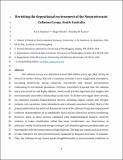Files in this item
Revisiting the depositional environment of the Neoproterozoic Callanna Group, South Australia
Item metadata
| dc.contributor.author | Stüeken, Eva E. | |
| dc.contributor.author | Buick, Roger | |
| dc.contributor.author | Lyons, Timothy W. | |
| dc.date.accessioned | 2020-09-23T23:35:58Z | |
| dc.date.available | 2020-09-23T23:35:58Z | |
| dc.date.issued | 2019-11-01 | |
| dc.identifier | 261444867 | |
| dc.identifier | caa38268-5eaa-4edd-bb07-d381814f2362 | |
| dc.identifier | 85073028831 | |
| dc.identifier | 000496875000008 | |
| dc.identifier.citation | Stüeken , E E , Buick , R & Lyons , T W 2019 , ' Revisiting the depositional environment of the Neoproterozoic Callanna Group, South Australia ' , Precambrian Research , vol. 334 , 105474 . https://doi.org/10.1016/j.precamres.2019.105474 | en |
| dc.identifier.issn | 0301-9268 | |
| dc.identifier.other | RIS: urn:386DC0A4049E09E70C7EB0A6B8800F9F | |
| dc.identifier.other | ORCID: /0000-0001-6861-2490/work/65014425 | |
| dc.identifier.uri | https://hdl.handle.net/10023/20677 | |
| dc.description | Funding was provided by the NASA postdoctoral program (EES) and by the NASA Astrobiology Institute through the Virtual Planetary Laboratory (RB, Cooperative Agreement No. NNA13AA93A) and the Alternative Earths Center (TWL, Cooperative Agreement No. NNA15BB03A). The Earth-Life Transitions Program of the NSF provided additional funds to TWL. | en |
| dc.description.abstract | The Callanna Group was deposited around 800 million years ago (Ma) during an interval in Earth’s history that saw a transition towards a more oxygenated atmosphere, increasing biodiversity among eukaryotic microfossils and climatic perturbations culminating in low-latitude glaciations. Previous researchers proposed that the Callanna basin was lacustrine and highly alkaline, which could provide important new insights into environmental cause-effect relationships at this time. To further interrogate these records, we examined standard biogeochemical proxies, including organic carbon and nitrogen isotopes, iron speciation, metal abundances and carbonate-associated sulfate. Much of the primary information has been lost because the rocks of the Callanna Group have experienced extensive metamorphism up to amphibolite facies and are altered by modern weathering. However, relics of these proxies, combined with sedimentological features, preserve evidence of redox stratification within this basin. Furthermore, our observations, in particular weakly fractionated nitrogen isotopes and abundant gypsum pseudomorphs, are incompatible with the interpretation of high alkalinity. The high salt content and occurrences of tidal indicators are most parsimoniously explained by frequent incursions of seawater. Thus, the Callanna Group cannot speak straightforwardly to environmental conditions in non-marine habitats at this time. Lastly, the absence of a large carbon isotope anomaly indicates that these rocks do not correlate with the Bitter Springs Formation. | |
| dc.format.extent | 2314001 | |
| dc.language.iso | eng | |
| dc.relation.ispartof | Precambrian Research | en |
| dc.subject | Callanna Group | en |
| dc.subject | Neoproterozoic | en |
| dc.subject | Evaporites | en |
| dc.subject | Metamorphic alteration | en |
| dc.subject | GE Environmental Sciences | en |
| dc.subject | DAS | en |
| dc.subject | SDG 14 - Life Below Water | en |
| dc.subject.lcc | GE | en |
| dc.title | Revisiting the depositional environment of the Neoproterozoic Callanna Group, South Australia | en |
| dc.type | Journal article | en |
| dc.contributor.institution | University of St Andrews. School of Earth & Environmental Sciences | en |
| dc.contributor.institution | University of St Andrews. St Andrews Centre for Exoplanet Science | en |
| dc.identifier.doi | https://doi.org/10.1016/j.precamres.2019.105474 | |
| dc.description.status | Peer reviewed | en |
| dc.date.embargoedUntil | 2020-09-24 |
This item appears in the following Collection(s)
Items in the St Andrews Research Repository are protected by copyright, with all rights reserved, unless otherwise indicated.

